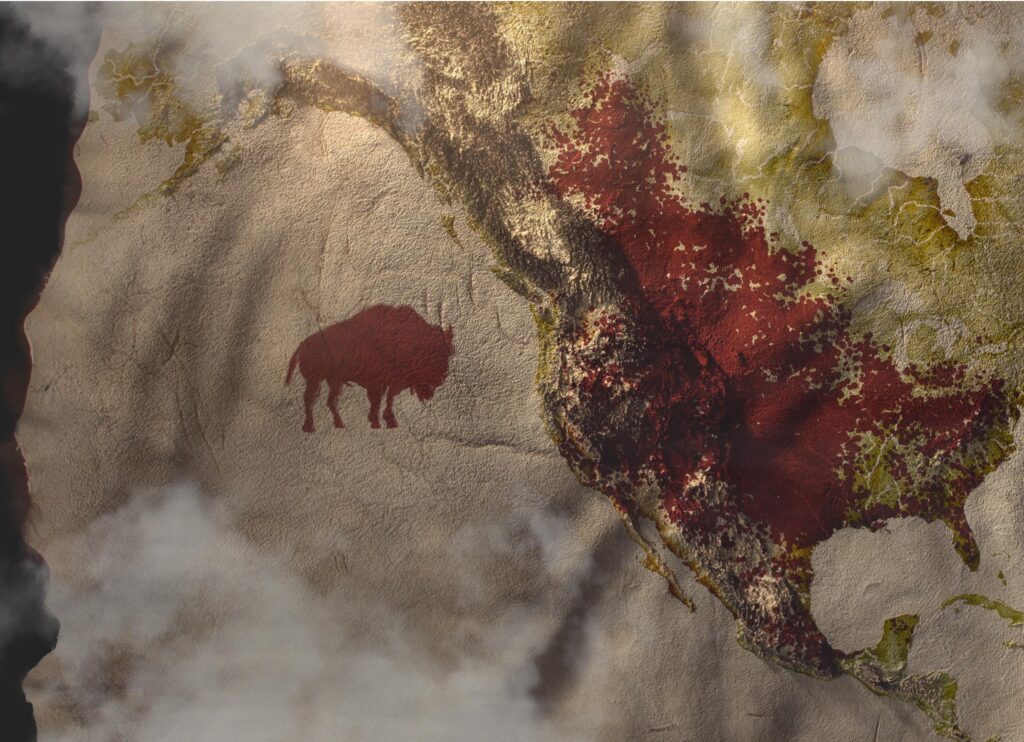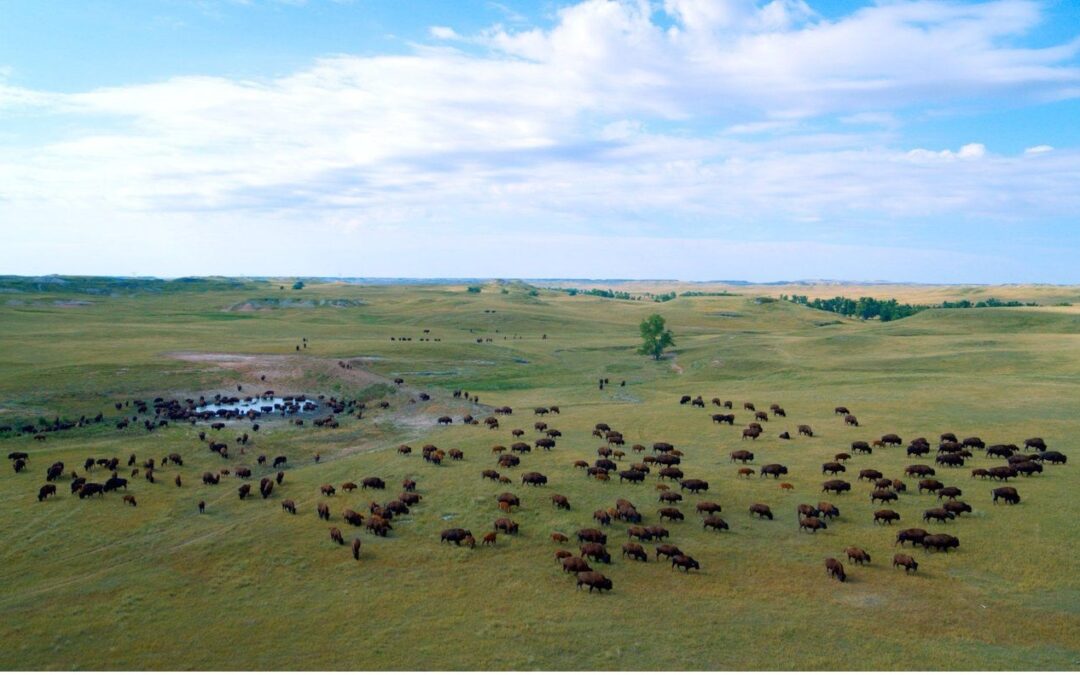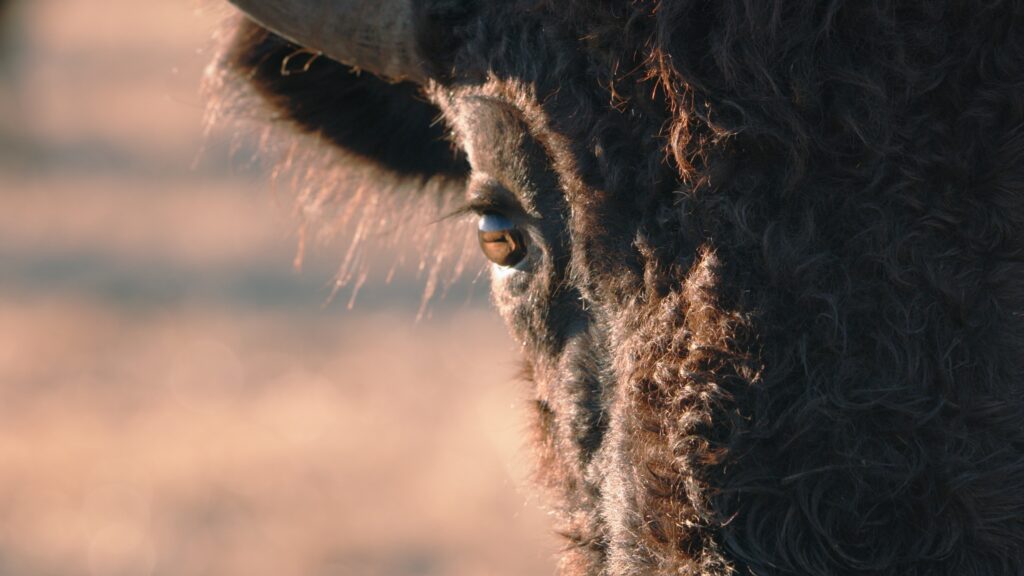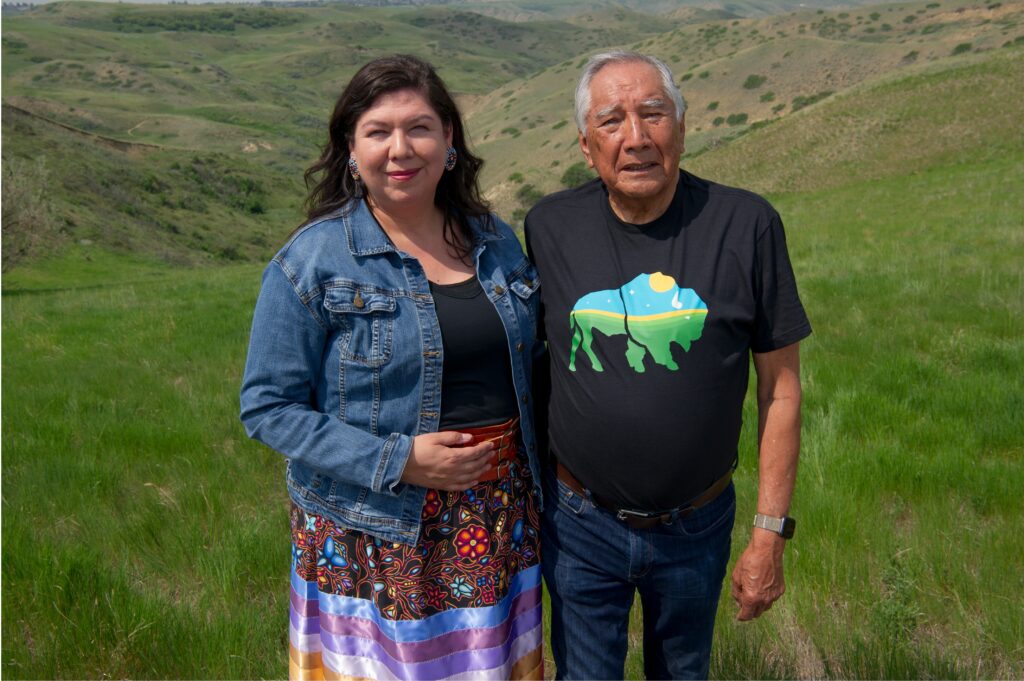A production still from “Singing Back the Buffalo.” Submitted photo
As her documentary Singing Back the Buffalo opens, Tasha Hubbard stands in a ribbon skirt beneath a pink sky in the windy grasslands of the Qu’Appelle Valley.
“When I was a little girl, I didn’t know what it meant to be a Cree person,” she begins.
“I was raised away by a farming family and the only time I felt connected was when we would come to the Qu’Appelle Valley. I’d stare at the empty hills and imagine my ancestors and the massive herds of buffalo moving across the land.”
In her late teens, Hubbard reunited with her birth family, yet an unshakeable sense of incompleteness lingered. It wasn’t until age 30 that Hubbard’s journey took a transformative turn. While attending a wedding, she joined a group that left the reception to explore a recently unearthed rock.
“It was a big rock in the shape of a buffalo. It had this really beautiful round medicine bowl at its nose. You just felt its energy. I felt so emotional. We talked about it for a while, and then they said we should sing for our Grandfather, so we sang an honour song for it,” Hubbard shared in an interview.
“For a moment we thought it sang back.”
After that experience, Hubbard’s interest in the buffalo, and their shared history with her Cree ancestors grew.
“That day I started my buffalo journey,” said the acclaimed filmmaker.
She’s spent 21 summers since visiting buffalo stones, and wrote a dissertation that concluded in 2016 as a part of her doctoral research on buffalo consciousness titled “The Call of the Buffalo: Exploring Kinship with the Buffalo in Indigenous Creative Expression.”
Her new documentary, Singing Back the Buffalo, debuted in “Montana” this past February, and is set to screen twice this week at the DOXA Documentary Film Festival in xʷməθkʷəy̓əm, Sḵwx̱wú7mesh, and səlilwətaɬ territories.
The first viewing is this Wednesday evening at the VIFF Centre’s Vancity Theatre, and it will be shown again on Thursday morning at SFU’s Djavad Mowafaghian Cinema.
‘Buffalo are our relatives’
A production still from “Singing Back the Buffalo.” Submitted photo
Hubbard’s roots trace back to Peepeekisis First Nation, nestled in Treaty 4 territory amid the serene sea of prairie grasses in the Qu’Appelle Valley of southern “Saskatchewan.” Her mother is Donna Pinay and her father is Albert Angus (from Thunderchild First Nation).
She currently resides in amiskwacîwâskahikan (Edmonton), and is an associate professor in the Faculty of Native Studies/Department of English and Film at the University of Alberta.
It has been a goal of hers to make a buffalo documentary from a completely Indigenous perspective for more than 20 years.
Buffalo, like their Indigenous kin, have endured a history of genocide. While they are experiencing a resurgence today, many find themselves constrained within fences and borders, deprived of the freedom to roam as they once did.
“We have this long-standing deep relationship with buffalo that got interrupted. Buffalo consciousness is a return to that awareness of how buffalo are our relatives and how this is their territory,” she said.

With distinctive grooves and depressions carved into their surfaces, buffalo ribstones — also known as Grandfather Stones — hold cultural and historical significance for Indigenous people within the plains regions. They were often placed strategically near buffalo jumps — cliffs or steep slopes used for communal buffalo hunting.
“Grandfather Stones found across the northern plains were and continue to be sites of renewal of our relationships to the buffalo and the land. Settlers have disrupted some of the stones,” Hubbard shared.
The film recounts the Cree and Nakota legend of the mōstos-awāsis asiniy, also known as the Buffalo Child Stone. It follows the story of a boy who grew up alongside the buffalo, only to realize his own humanity one day when he saw his reflection in the water. Seeking to understand his identity, he leaves to connect with his human kin and eventually starts a family of his own.
However, feeling a deep longing for his buffalo family, he returns seeking guidance. His grandfather advises him that by rolling over four times, he can transform into the mōstos-awāsis asiniy, a sacred stone the human people can visit to pay tribute to the buffalo people for their sacrifices.
“I asked myself, how did it impact us to lose this being that we were so connected to? How did that affect us as a people?” Hubbard said.
Recognizing the historical parallels of captivity faced by both the buffalo and Plains Indigenous communities, coupled with the displacement of Indigenous populations to reserves and the imposition of the pass system in “Canada,” Hubbard saw the correlation with each respective genocide.
“We were literally confined to our reserves and at a low population. The same thing happened with the buffalo. They were at their historic low and have primarily only existed as domesticated since then. There are a handful of wild buffalo, but confinement has been their fate for a really long time,” Hubbard said.
Rebuilding longstanding connections

On Turtle Island, there once existed a crucial cycle of interdependence between buffalo, humans, and the land, until it was abruptly interrupted. With the introduction of diseases from European cattle and concerted efforts by the government, military, and hide hunters, the buffalo were almost entirely wiped out.
By 1883, the immense buffalo herds, once numbering tens of millions, became only a few orphan calves, some in captivity, and a refugee herd in Yellowstone. By 1889, their population had plummeted to a mere few hundred.
Stunning animations of buffalo herds breathe life into the film, their majestic essence conveyed through resonant grunts and the rhythmic pounding of their hooves.
Hubbard also thoughtfully incorporated archival images throughout the film, providing viewers with visual glimpses into the past and deepening their comprehension of the sombre history surrounding their decline.
“Most people have seen the [image] where the man is standing on the mound. We purposely didn’t use that one because we all know that image. Instead, I was taken by the one that showed the scale,” Hubbard shared.
Currently, the only continuously free, unfenced herd of buffalo is the one in Yellowstone Park, estimated to number around five thousand. These buffalo instinctively follow their seasonal migration routes, paying no heed to park boundaries or borders. However, once they cross into “Montana,” they face the threat of being shot. This practice has sparked opposition from many Indigenous groups.
The feature-length documentary’s narrative centres on The Buffalo Treaty, which was first signed on September 24, 2014, at the Blackfeet Reservation in “Montana.” At its heart, the treaty is about cooperation, renewal, and restoration.
The Blackfeet Nation, the Kainai/Blood Tribe, the Siksika Nation, the Piikani Nation, the Assiniboine and Gros Ventre Tribes of Fort Belknap Indian Reservation, the Assiniboine and Sioux Tribes of Fort Peck Indian Reservation, the Salish and Kootenai Tribes of the Confederated Salish and Kootenai Indian Reservation, and the Tsuuuut’ina Nation were the first nations to sign.
As of February 2024, there have been almost 50 sovereign signatories.
Hubbard has been working alongside, Dr. Leroy Little Bear, a member of the Kainai Tribe of the Blackfoot Confederacy in “Alberta,” and an Indigenous scholar, lawyer and thinker. He plays a prominent role in spearheading the Buffalo Treaty among First Nations in “Canada” and tribes in the “United States.”
Tasha Hubbard and Dr. Leroy Littlebear. Submitted photo
The two of them are also founding members of the International Buffalo Relations Institute alongside Amethyst First Rider (also seen in the documentary) among others.
“Our Elders were concerned that we still have the songs, we tell the stories, we have the ceremonies but there is no buffalo to be seen out there,” shared Dr. Little Bear.
“They almost went extinct. Well, we need to bring that buffalo back so that our Youth will make that connection. So that when they hear those songs, they’ll know what they’re singing about”
In one scene, the Wolakota Buffalo Range — a nearly 28,000-acre native grassland — hosts a buffalo harvest with Youth as part of Lakota Immersion School.
The Youth are involved in processing these animals, rebuilding their connections and lifeways to the buffalo. One impressive Youth, with a butcher knife in hand, teaches the adults how to butcher them. The scene ends with the Youth singing a song and doing a buffalo dance.
“At its heart, the film is about what we want in the future. Looking ahead and going, what does it mean to have things set back to balance?” Hubbard said.
“My goal was always to want people to smell that prairie. It’s beautiful and golden, and it’s hard to describe. It’s for people who have, for all sorts of reasons, been disconnected from their homelands. Wanting to bring people back there on the screen. And, hopefully, they get to go there one day.”
Recognized as a keystone species, buffalo serve as ecosystem engineers, crucial for preserving biodiversity, facilitating nutrient cycling, seed dispersal, and providing sustenance for predators including wolves and grizzly bears, according to the film.
They also could serve a crucial function in adapting to climate change, particularly within the context of Indigenous food sovereignty. Restoring buffalo as a fundamental food source, guided by sacred protocols and agreements, is vital for nurturing community health and prosperity.
The film tells a prophecy of the buffalo’s return, a vision that is already unfolding before our eyes.
“We need to not just bring them back, but bring them back in a way that they can be more like how they’re meant to be,” Hubbard says.
“It’s justice. Buffalo justice.”
By: Kayla MacInnis, Local Journalism Initiative Reporter, IndigiNews


